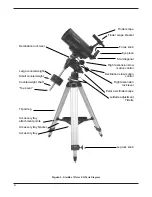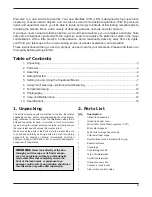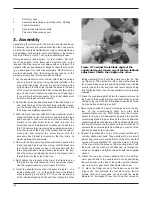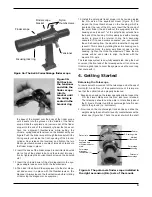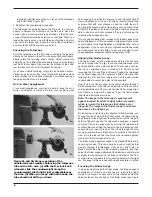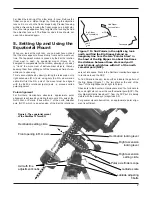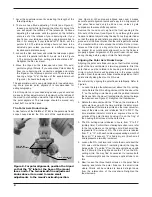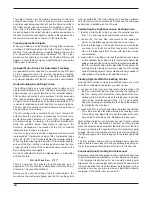
7
3a). Back the lock ring off by a few turns, for now. Refocus the
finder scope on a distant object by threading the objective
lens cell in or out on the finder scope body. Precise focusing
will be achieved by focusing the finder scope on a bright star.
Once the image appears sharp, retighten the lock ring behind
the objective lens cell. The finder scope’s focus should not
need to be adjusted again.
5. Setting Up and Using the
Equatorial Mount
When you look at the night sky, you no doubt have noticed
that the stars appear to move slowly from east to west over
time. That apparent motion is caused by the Earth’s rotation
(from west to east). An equatorial mount (Figure 6) is
designed to compensate for that motion, allowing you to easi-
ly “track” the movement of astronomical objects, thereby
keeping them from drifting out of the telescope’s field of view
while you’re observing.
This is accomplished by slowly rotating the telescope on its
right ascension (R.A.) axis, using only the R.A. slow-motion
cable. But first the R.A. axis of the mount must be aligned
with the Earth’s rotational (polar) axis - a process called
polar alignment.
Polar Alignment
For Northern Hemisphere observers, approximate polar
alignment is achieved by pointing the mount’s R.A. axis at the
North Star, or Polaris. It lies within 1° of the north celestial
pole (NCP), which is an extension of the Earth’s rotational
axis out into space. Stars in the Northern Hemisphere appear
to revolve around the NCP.
To find Polaris in the sky, look north and locate the pattern of
the Big Dipper (Figure 7). The two stars at the end of the
“bowl” of the Big Dipper point right to Polaris.
Observers in the Southern Hemisphere aren’t so fortunate to
have a bright star so near the south celestial pole (SCP). The
star Sigma Octantis lies about 1° from the SCP, but it is barely
visible with the naked eye (magnitude 5.5).
For general visual observation, an approximate polar align-
ment is sufficient.
Figure 6: The equatorial mount
of the StarMax 127mm EQ
Big Dipper
(in Ursa Major)
Little Dipper
(in Ursa Minor)
Cassiopeia
N.C.P.
Poin
ter
Stars
Polaris
Declination setting circle
Front opening in R.A. axis
Azimuth fine
adjustment knobs
Declination locking lever
Right ascension
locking lever
Right ascension
setting circle
Polar axis finder scope
Latitude scale
Latitude adjusting
T-bolts
Figure 7. To find Polaris in the night sky, look
north and find the Big Dipper. Extend an
imaginary line from the two "Pointer Stars" in
the bowl of the Big Dipper. Go about five times
the distance between those stars and you'll
reach Polaris, which lies within 1° of the north
celestial pole (NCP).
DE
CL
IN
AT
IO
N A
XI
S
RIG
HT A
SC
EN
SIO
N A
XIS


